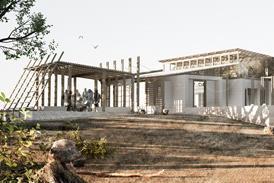Tanvir Hasan argues that the growing web of regulation and risk aversion is accelerating the loss of historic craftsmanship – and with it, our ability to repair and care for buildings sustainably

I, like many Londoners, live in a late Victorian mansion block. In August last year our freeholders sent us all a letter informing us that our front doors needed upgrading for fire, and suggested a company that could replace our non-compliant doors with fire-graded replicas. It was an easy, expensive option.
The front door to my flat, like many in the block, is an original two-panelled late 19th-century door. It is 50mm thick, made of slow-grown pine or spruce, with a solid lower raised and fielded panel and an upper panel which began its life as a decorative glazed panel. The door had a similarly glazed door light above.
In the 1950s, to comply with new regulations, the decorative glass was changed for the more secure and better fire-protected “Georgian wired” glass, as was the door light above.
In the 1970s, as fire regulations changed, the Georgian glass was taken out and replaced with the wonder material that was asbestos. The upper door light was blocked completely with asbestos sheets.
So the door continued its life. It was painted and various owners went in and out of it, bringing up families, growing old, and adding memories to the flats they lived in, all protected by this wonderfully strong door.
We moved into the flat about 15 years ago and, like everyone before us, painted the door and admired the fabulous ironmongery, the lovely letter slot, and the security blocks in the hinges and thickness of its timber.

Alas, fire regulations have changed again, and this time the door is unable to accommodate what is being asked of it. Not because the asbestos panel is causing problems, not because the paint cannot be changed for intumescent paint, not because there is no desire to keep the old door, but because, without going into details, it has been made all too difficult by regulation upon regulation.
In short, the cost of asbestos removal is so complicated, and getting a refurbished door certified for fire is even more so. All in all, it is easier to replace the door than to try and keep it.
Therefore, as we speak, hundreds of thousands of wonderful heavy doors that we have lived with happily for hundreds of years, in some cases, are being binned, burnt, shredded and lost. Where, I ask, is the sustainability in all this? Where is the conversation about virgin material, about embedded energy, etc.?
When our freeholder’s note came around, the residents’ group app was wild with worry, asking about the process and cost. The internet was scoured for companies and options for how to upgrade doors. It appeared that many new companies had emerged to resolve this problem suddenly facing us all, with nothing but internet references as their recommendation.
Thus, the solutions each resident took were different. As long as a certificate was provided, our helpful freeholder could satisfy the insurers and comply with the new building regulations.
I have stopped my door from being replaced and will come up with a way of saving it, but I am a conservation architect. I am happy to spend money saving old things, and I know how to do this.
What does everyone else with less appetite to fight for the cause do? How do the many mansion blocks in England deal with upgrading their doors? This perhaps comes back to the long saga of losing our craftsmanship and having an insurance industry with little imagination and no desire to think laterally.
Any solution which is not standard is not acceptable
If we still had good joiners who understood how doors are assembled, they could have been deployed to work alongside the asbestos removal specialists to replace the asbestos panels with plywood, and to do it quickly and efficiently. This issue of loss of craftsmanship and lack of maintenance routines needs attention and focus from the building industry as a whole.
The building regulations and fire specialists, along with the insurance industry too, need to be on board. For an old door to be refurbished and deemed to be fire safe, it has, says the building regulation, to be certified.
With the use of correct materials, correct paint, and intumescent seals, a refurbished old door could be deemed a fire door, but it needs a specialist to certify it. Where are these specialists, and who are they?
The difficulty also lies in the risk assessment used by the insurance agencies. Any solution which is not standard is not acceptable.
Fire engineers who understand old fabric can certify historic doors as fire doors, but they are rare and difficult to find. Moreover, they are extremely overworked.
On larger projects, of course, there are the funds to employ an enlightened fire engineer, but for the large majority the obvious solution is to use a fire-grade block door and plant decorative moulding on it. Alas, this is not sustainable and an extremely worrying situation to be in.
But my moan about losing old timber joinery is not limited to doors. On a daily basis, we lose hundreds of thousands of old timber windows, only because the contractors “retrofitting” them cannot guarantee the repairs needed. We rely more and more on guarantees and warranties and less and less on craftsmen and maintenance, and less and less on prolonging the life of materials.
I feel architects are losing words such as “dovetail joints” and “tingling slates” because they are no longer part of our experience
Normally, if a window has a rotten section, you would call a joiner who would cut out the damaged portion, scarf in new timber, or adjust the weights and ease it all, but the windows would be as good as new. Not any more. Now any damaged old window which may have survived for hundreds of years is taken out, binned, and replaced with a new one with a 20-year guarantee.
Where is the logic in that? Why do we think that if something stops working, you replace it and not repair it?
With our new sustainability awareness, we are aware of reusing old materials, but perhaps in a bizarre, illogical way. On a recent project, I was told, perhaps just to tick the sustainability box, that you can chop up a solid teak (non-compliant) handrail and turn it into flooring.
I must say I was a bit taken aback. You mean spend lots of energy on a machine to slice the handrail to turn it into a few square metres of flooring?
Even twenty years ago we all went to Lassco to buy bits and pieces for our buildings. My redundant handrail would have gone there. But now the insurance industry and building control have such a tight grip on everything that my non-compliant handrail is only valid for very small usage.
A recently published book called Lost Words by Robert Macfarlane and illustrator Jackie Morris points to words such as “acorn” and “bramble” being removed from the Oxford Junior Dictionary because children are no longer exposed to nature. I feel architects are losing words such as “dovetail joints” and “tingling slates” because they are no longer part of our experience.
Is it time we start thinking differently, and is it time the building regulations are changed to keep up with our crisis? Finally, is it time the insurance industry begins to think more imaginatively?
>> Also read: Heritage and post-conflict reconstruction in Mosul
>> Also read: The Elefante in the room
Postscript
Tanvir Hasan is a Director Emeritus at Donald Insall Associates, having served as Deputy Chairman and London studio lead for over a decade.
















No comments yet